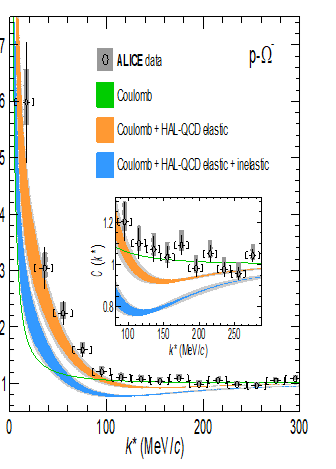A new laboratory for the strong interaction

The strong interaction among hadrons
One of the biggest challenges in nuclear physics today is understanding the strong interaction between hadrons with different quark content from first principles, that is, starting from the strong interaction between the hadrons’ constituent quarks and gluons.
Recently, a well-known technique in ultra-relativistic heavy ion collisions, based on the measurement of the momentum difference between hadrons was applied to proton–proton collisions at the LHC to measure the dynamics of the strong interaction between hyperons and nucleons. Even rare and so far, unmeasured combinations, such as proton-Omega (sss) could be investigated and the predictions by first principles calculations for their strong interaction could be tested.
Figure 1 illustrates how the method works. The correlation function shown in panel c) and measured as ratio of hadron pairs in the same event to hadron pairs in mixed event, can be expressed as an integral over the relative coordinates of the pair of interest. This integral contains a source term a) and the relative wave function of the two particles. The latter can be calculated solving the Schrödinger equation for a given interaction potential b). The resulting correlation function dependent from the pair relative momentum k*, d), carries the imprint of the interaction.

Figure 1: Schematic representation of the correlation function.
The technique is called femtoscopy because it allows investigating spatial scales close to 1 femtometer (10−15 metres) – about the size of a hadron and the spatial range of the strong-force action. An example of such correlations is provided in Figure 2, where the proton-Omega measurement extracted from pp collisions at 13 TeV, with a high multiplicity trigger, is shown.

Figure 2: Measured p-W- correlation together with the predictions by HAL QCD that include the Coulomb and strong interactions.
The fact that the correlation is larger than one for small values of the pair relative momentum k*, implies an overall attractive interaction. The predicted correlation function assuming only an attractive Coulomb interaction shown in green is not sufficiently attractive to provide a quantitative agreement to the experimental data, but the calculations by the lattice group HAL QCD, that include also a strong attractive interaction, improved the agreement significantly. Basically all hadron combinations can be studied in this manner to determine the strong interaction parameters, provided that a sufficient large pairs statistics is measured.
Aside being very important for nuclear physics, such studies bare important implications for the physics of neutron stars, in which interior hyperons could appear. The appearance of hyperons depends on their interaction with neutrons and many of these interactions are still poorly known. Thanks to the new method ALICE will be able to measure all the missing interactions and contribute to the understanding of the densest objects we know in our Universe.
[1] ALICE Coll. Nature 588, 232–238 (2020)
